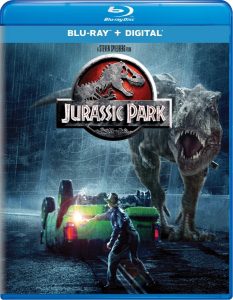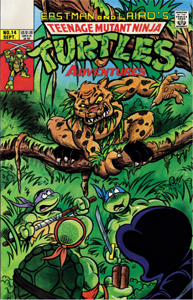In “TMNT Adventures” Issues 12-20 (1990-91), writer Dean Clarrain (real name Stephen Murphy) goes full bore into both environmental themes and world-building that’s totally distinct from the cartoon. Your mileage may vary with that first point.
Clarrain – who co-created the “Adventures” timeline with Ryan Brown in Issue 5 — undeniably has an agenda, but he meshes that into adventure yarns quite well. He gradually gets better at backing up his points about industrial plunder of the Earth by exploring detailed circumstances.
Endangerers and polluters
In “Fight the Power” (17), Man-Ray informs us (and April and the Turtles) about shrimp nets that allow endangered sea turtles to escape. But the villainous shrimpers of the piece don’t use those nets; they’re fine with the turtles dying.

“Teenage Mutant Ninja Turtles Adventures” Issues 12-20 (1990-91)
Archie Comics
Issues: “The Lost World” (12), “The Final Conflict” (13), “Leave Heaven Alone” (14), “The Howling of Distant Shadows” (15), “Dreadging the Ocean Blue” (16), “Fight the Power” (17), “Mondo Metal” (18), “The Man who Sold the World” (19), “Sun and Steel” (20)
Writer: Dean Clarrain (Stephen Murphy) (all)
Pencils: Ken Mitchroney (12, 13, 15, 16, 17, 18), Don Simpson (14), Marlene Becker (18), Garrett Ho (19), Bill Wray (20)
Inks: Dan Berger (12-19); Hilary Barta, John Beatty, Mark Pacella (20)
Colors: Barry Grossman (all)
This batch of issues kicks off with a battle on the Krang-devastated Dimension X world Hirobyl (likely a blend of Hiroshima and Chernobyl) in “The Lost World” (12) and “The Final Conflict” (13), a bigger reprise of “Intergalactic Wrestling” (7). Krang’s enemy Mary Bones quickly turns into her true, beautiful form as Cherubae – a missed opportunity (so far) for a NECA action figure two-pack.
When Leatherhead finds the Turnstone – thus allowing Cherubae to wish it out of existence – the now-benevolent Cherubae explains to Leatherhead that she foresaw that she needed his help, and that’s why she had (seemingly cruelly) transformed him. This two-parter smacks of a quick wrap-up by new writers taking over for old writers, but actually Clarrain has been shepherding this whole story.
It is nice to set Krang, Shredder, Bebop and Rocksteady aside, though, as the cartoons featured them in almost literally every episode. “Adventures” gives us Null, who is so clearly an uber-villain (human, but with small horns) that we can’t accuse Clarrain of using him as a stand-in for your average corporate boss who is reckless with the environment.
In the tragic “Dreadging the Ocean Blue” (16), Null is dumping waste – from his Brazilian mining operation from previous issues — into the ocean. Interestingly, Shredder is also a waste-dumper, although he uses the NYC sewers, which doesn’t seem as bad although it probably results in the same end game. Some of the mutagen from his leftover base spills on a teen rocker in “Mondo Metal” (18), and in a surprising roll-with-the-punches way, Mondo Gecko immediately embraces being a mutant.

The first steps into a larger world
But as for the second defining trait of Clarrain’s work, there’s no denying that “Adventures” gains forward narrative momentum and endless possibilities that make it 180 degrees removed from the comparatively staid cartoon (which gleans entertainment from humor).
Unless you find the environmentalism totally off-putting, “Adventures” is worth reading just for things like April being a more proactive character than in the cartoon. Granted, the first time we catch up with her “Adventures” persona, in “Leave Heaven Alone” (14), she has been kidnapped. But not by Shredder. Instead by Null’s henchmen, as she is ambitiously reporting on environmentally disastrous mining in Brazil.
In this issue and “The Howling of Distant Shadows” (15), we meet Jagwar and Dreadmon (who were snubbed by Playmates but have become a NECA two-pack), under-explained anthropomorphs who personify (and talk about) the rainforest’s cycle of life.
The character designs are great, the characterizations shallow, and the world-building quite imaginative as our heroes come upon a Lost World inside a dormant volcano. It’s the slightest degree more developed and explained than the random Lost World in the toon’s “Turtles at the Earth’s Core” – but that degree is enough to make “Adventures” comparatively mature and serious.
April takes up martial arts
April (trading the yellow jumpsuit for safari gear) may have been kidnapped, but she is headstrong, intending to go down insulting her captors. A few issues later, she borrows one of Leo’s katanas and asks Splinter to give her some training in sword work.
I had forgotten how quickly “Adventures” April embarks on her martial-arts training, drastically diverging from other incarnations (although Movie April would become a swordswoman in 2007’s “TMNT IV,” a stunning change from Paige Turco’s awkward attempt at nunchuck twirling in 1992’s “TMNT II”).
Of course, April is glad to be rescued by the Turtles, who have been conveniently deposited there by Cudley in a sort of “Quantum Leap” situation where our heroes are dropped off where needed.
The fact that “Adventures” goes to a specific planet in Dimension X, then Brazil, then the ocean floor, then New Orleans, then back to New York makes it feel bigger than the cartoon’s world, which is primarily confined to NYC. These Turtles and their friends quickly become worldly.
And the fate of the planet is indeed at stake in “The Man Who Sold the World” (19), although Team Green rather dumbly beats up Null’s defecting henchman, Kid Terra, before he can explain that Null has traded the Earth to Maligna (a giant cockroach queen who is another of Krang’s warlord rivals) in exchange for Dimension X mineral rights. Similar to Spike in “Buffy” Season 2, Kid Terra may be bad, but he doesn’t want Earth to be destroyed, because that’s no fun.
One more hot action figure
As the Null conflict jumps over to “Mighty Mutanimals” miniseries Issue 1, “Sun and Steel” (20) is an anticlimactic end to this batch (It’s really a standalone story). The yarn’s “worldliness” is more along the lines of the cartoon. A young Chinese man can turn into a giant dragon for mystical Asian reasons.
Even more random is the giant Foot Soldier — unless you consider the need to launch action figures, which is the reason for a lot of these stories (including Mondo’s). However, there was no giant Foot Soldier nor giant dragon – although the regular-sized 1992 figure Hothead (red instead of yellow) is likely meant to represent the transformed Chu Hsi.
“Sun and Steel” features an epic cover of Hothead and the Foot Soldier fighting next to the Statue of Liberty, and that’s how a lot of these covers are. (See also how cool Jagwar, Dreadmon and Mondo look on their covers.)
“Adventures” always promises something big, but the conflicts and fights within the pages are thinner in both story and art. The action is better than the cartoon’s, but far short of Mirage; appropriate, I suppose, because that’s where the stories land, too.
Issue 20 ends with a tease of Shredder’s return (via the Turnstone, Cherubae had magically dispatched him to an undefined prison in Issue 13). So “Adventures” isn’t venturing too far from the core conflict. Still, these nine issues go down as a veritable explosion of world-building amid the Earth-hugging.

